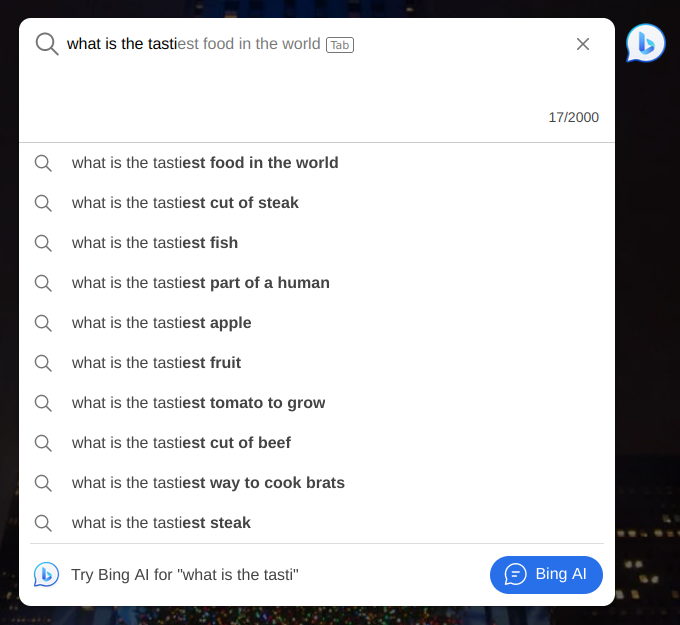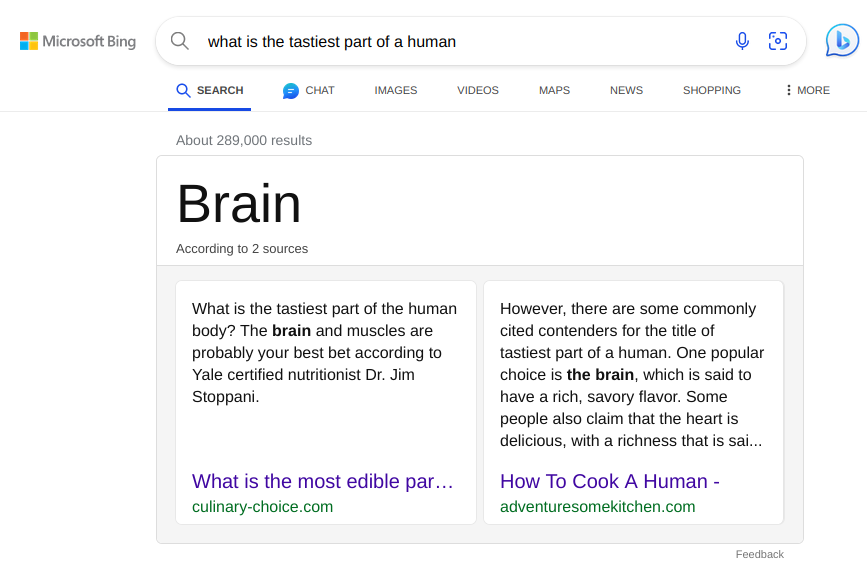Microsoft recommends eating human brains
There has always been a certain amount of garbage on the internet, but I feel like there was a time, not so long ago, that giant tech companies would have shied away from suggesting that we eat human brains.
The recent proliferation of large language models – some people call them AI, but I won’t, for reasons that will become obvious – has made it easier than ever for computers to generate text-like nonsense and to grasp the wrong end of the stick when analysing them.
If you start typing “what is the tasti…” into Bing (in a fresh browser with no cookies), it quickly comes up with an interesting suggestion:

Bing’s suggested search queries
Let’s see what it suggests for that fourth option, shall we? What is the tastiest part of a human? Next to the prominent Microsoft branding, in large type, the confident answer is given: Brain.

According to Microsoft, the brain is the tastiest part of a human.
The two sources cited for this claim are interesting choices. Their domain names,
“culinary choice”,
and “adventuresome kitchen”,
(those are nofollow links to avoid giving them any more of a boost)
give the appearance of
unexceptional recipe websites. And, to be fair, eating human brains is
certainly a choice, and an adventuresome one. But they are not good sources.
Both sites consist solely of automatically generated logorrhoea about food and
cooking, apparently seeded from lists of topics exhibiting a rather catholic
view of what constitutes an edible ingredient.
The pages are clearly not written by a human being, or by anything that actually understands the content. They have a superficial plausibility, but it doesn’t stand up to scrutiny. There are other hallmarks of LLM-generated text, too, like excessive repetition, or a strangely chatty tone.
Some of the content is made from fragments scavenged from other websites but stripped of context. Other parts appear to be entirely hallucinated.
One popular choice is the brain, which is said to have a rich, savory flavor.
The word “popular” is doing a lot of work in this sentence.
But in general, you can eat most human organs with few risks. Just be sure to consult a doctor before eating any organ to make sure that it is safe for you to eat.
Go on, ask your GP, see what they say!
A third way to cook a human body is to freeze it. This is a slow process, and the body will be completely cooked in a few months.
Wrong, but fascinating. Is this due to the semantic closeness between cook and burn and freeze and burn, perhaps?
So, if you’re curious about what the tastiest part of a human is, be sure to try a little bit of everything to find out for yourself!
Please don’t.
The second article features a byline, headshot, and bio for the alleged author. I somehow doubt that a model married to a rock star is actually moonlighting as a cannibal chef. Just a hunch.

She loves to try new recipes
But for me, the thing that conclusively proves that these articles weren’t written by a person is that neither of them suggests a side dish or wine pairing (Chianti or Amarone?). For shame.
Large language models haven’t delivered artificial intelligence, they’ve given the internet the digital version of kuru, and megacorps are contracting it as they rush to keep up with the latest fad.